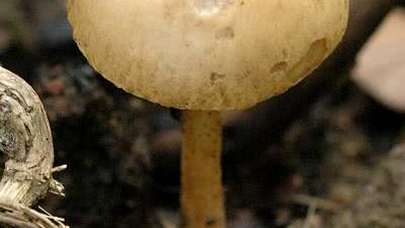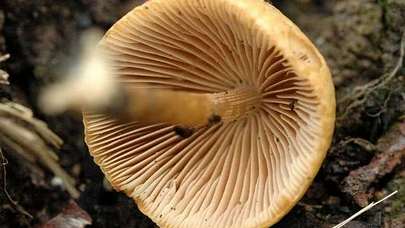Agrocybe pediades
Description
Agrocybe pediades is a typical lawn and other types of grassland mushroom, but can also grow on mulch containing horse manure. This common inhabitant of grassy areas is characterized by a smooth (sticky when moist), buff-brown cap, brown spores, slender stipe, and a soon disappearing fibrillose veil.
Agrocybe pediades is easily confused with some highly poisonous brown mushrooms and should be avoided when collecting for consumption.
Common names: Common Fieldcap Mushroom.
Mushroom Identification
Ecology
Saprobic; growing alone or gregariously in lawns, meadows, and other grassy areas (also sometimes on woodchips, manure, or compost); summer, or nearly year-round in warm climates; originally described from Europe; common and widely distributed in North America; also found in the Caribbean, South America, Asia, and Oceania.
Cap
1–3 cm across; convex, becoming broadly convex or nearly flat; bald; sometimes sticky when fresh; dark honey yellow, fading to pale brownish yellow; often with a thin strip of white partial veil remnants on the margin when very young.
Gills
Narrowly attached to the stem; close or nearly distant; short-gills frequent; pale yellow-brown becoming darker brown; when young covered by an ephemeral white partial veil.
Stem
2–8 cm long; 2–4 mm thick; more or less equal; bald or finely fibrillose; colored like the cap; sometimes twisted; basal mycelium white.
Flesh
Whitish; not changing when sliced; thin.
Spore Print
Dull brown with a hint of cinnamon.
Look-Alikes
-
Has slightly distant, cream-colored gills and white spores.
-
Has a purplish gills, purple-brown spores and a striate-edged annulus.
-
Has a darker-brown cap, mottled dark gills and dark-brown spores. To confirm an identification, a microscope is needed to check the cuticle which is cellular and the spores which have an apical pore.
-
Grows in spring, summer, and early summer on grasses, forest margins, and sawdust mulch; it usually has a pale yellow cap that fades more with age, and almost always has a stem ring.
History
In 1821 Elias Magnus Fries described this species and gave it the scientific name Agaricus pediades.
In 1889 Swiss mycologist Victor Fayod (1960 - 1900) transferred this species to the genus Agrocybe establishing its currently accepted scientific name Agrocybe pediades.
The term "fieldcap" is derived from Agro-, of fields, and -cybe, head or cap, and its direct translation of the generic name Agrocybe. The specific epithet pediades means "of the plains", or "of the soil".
Synonyms
Naucoria pediades (Fr.) P. Kumm., 1871
Simocybe pediades (Fr.) P. Karst., 1879
Nolanea pediades (Fr.) Sacc., 1887
Naucoria pediades var. obscuripes Fayod, 1889
Naucoria arenaria Peck, 1912
Naucoria subpediades Murrill, 1942
Naucoria arenicola (Berk.) Sacc., 1887
Agrocybe arenicola (Berk.) Singer, 1936
Agrocybe pusilla (Schaeff.) Watling, 1981
Naucoria semiorbicularis (Bull.) Quél., 1872
Simocybe semiorbicularis (Bull.) P. Karst., 1879
Hylophila semiorbicularis (Bull.) Quél., 1886
Agrocybe semiorbicularis (Bull.) Fayod, 1889
Naucoria arenaria Peck, 1912
Agaricus pusillus Schaeff.
Agaricus semiorbicularis Bull.
Agaricus pediades Fr.
Agaricus arenicola Berk.
Photo sources:
Photo 1 - Author: Terri Clements/Donna Fulton (pinonbistro) (CC BY-SA 3.0)
Photo 2 - Author: Alan Rockefeller (CC BY-SA 4.0)
Photo 3 - Author: James K. Lindsey (CC BY-SA 2.5)
Photo 4 - Author: leschampignons (CC BY-SA 3.0)
Photo 5 - Author: James K. Lindsey (CC BY-SA 2.5)





